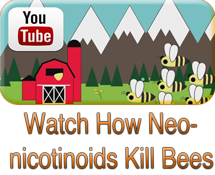June 2014 British publication confirms long-term persistence of neonicotinoids in soils!
18/06/2014
British Food and Environment Research Agency (FERA) has recently published a study reporting persistence of neonicotinoids in soil. This study demonstrates long-term presence of neonicotinoids in soil, especially for imidacloprid that could be found in absence of any seed-treatment with this substance in the past 3 years. Concentrations around 10 ppb were commonly found, which is highly worrying, considering the important solubility of these chemicals and the rapidity of absorption of these compunds by flowering plants.
Another interesting result is the demonstration that non-sown edges of fields may present important concentrations of neonicotinoids that will probably contaminate wild flowering plants.
These results confirm the persistence of neonicotinoids in soils and raise the urgent need to assess the issue of neonicotinoids uptake by succeeding crops and wild flowers. Furthermore, the majority of wild pollinators nest in soils or have part of their reproductive cycle in soils and the assessment of such soil contamination is more than urgent.
Pubmed abstract (full publication not freely available):
Neonicotinoid Concentrations in Arable Soils After Seed Treatment Applications in Preceding Years.
Abstract
BACKGROUND:
- Concentrations ofneonicotinoid insecticides clothianidin, thiamethoxam and imidacloprid were determined in arable soils from a variety of locations in England RESULTS: In soil samples taken from the central area of fields, concentrations of clothianidin ranged from 0.02 µg/kg to 13.6 µg/kg. Thiamethoxam concentrations were between <0.02 µg/kg and 1.50 µg/kg, imidacloprid concentrations were between <0.09 µg/kg and 10.7 µg/kg. Concentrations of clothianidin and thiamethoxam were lower in soil samples taken from the edges of fields than from the centres of fields but this difference was less pronounced for imidacloprid.
CONCLUSION:
This work gives a clear indication of the levels of neonicotinoids in arable soils after typical use of these compounds as seeddressings in the UK. There was evidence that imidacloprid was more persistent in the soils studied than clothianidin and thiamethoxam. Since clothianidin and thiamethoxam have largely superseded imidacloprid in the UK, neonicotinoid levels were lower than suggested by predictions based on imidacloprid alone.
This article is protected by copyright. All rights reserved.
KEYWORDS:
Apis mellifera; bumblebee; clothianidin; honeybee; imidacloprid; neonicotinoids; pollinator; soil; thiamethoxam

